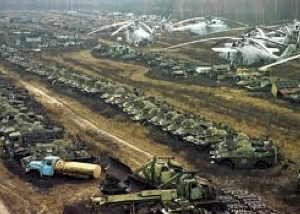 I remember days and nights spent at a rewrite desk in Washington 25 years ago, taking in and editing nearly unbelievable information from reporters in Russia and Western Europe. Where was this place, Chernobyl? Was the meltdown first, or the explosion? Was radiation really spreading across Europe? Do we have a stringer in Norway? How could this happen? (photo: graveyard of irradiated vehicles at Chernobyl. credit unknown)
I remember days and nights spent at a rewrite desk in Washington 25 years ago, taking in and editing nearly unbelievable information from reporters in Russia and Western Europe. Where was this place, Chernobyl? Was the meltdown first, or the explosion? Was radiation really spreading across Europe? Do we have a stringer in Norway? How could this happen? (photo: graveyard of irradiated vehicles at Chernobyl. credit unknown)
Chernobyl stood for a generation as the worst possible nuclear accident, and the Western nuclear industry constantly pointed out Chernobyl’s Soviet design defects. Yet Japan, with cascading failures at multiple U.S-designed reactors, may end up being worse.
The most disturbing information, then and now, is the tales of human error and government or corporate neglect that emerge in bits and pieces after the fact.
As U.S. officials warn that one of the pools holding spent nuclear fuel at Japan’s crumbling Fukushima nuclear complex has boiled dry and may burn or even explode, we find that the plant has a history of safety issues, even cover-ups. From the Christian Science Monitor:
TEPCO [the Tokyo Electric Power Co.]has come under fire in the past for falsifying safety records at the Fukushima Daiichi plant. In 2002, according to The Wall Street Journal, TEPCO admitted to the Nuclear and Industrial Safety Agency that it had falsified the results of safety tests on the No. 1 reactor.
This was only one in a string of scandals and coverups to mar the Asia’s biggest utility company. In 2007, the company initially said there was no release of radiation after an earthquake damaged its Kashiwazaki-Kariwa plant, but later admitted that radioactive water spilled into the Sea of Japan.
And less than a year ago, on June 17, a reactor at Fukushima I lost electricity and saw a dangerous drop in cooling water, Bloomberg reported. TEPCO’s president failed to adequately investigate to prevent the current crisis, said Iwaki City council member Kazuyoshi Sato.
When it comes to profit over safety, corporate behavior is the same the world over. If regulators turn a blind eye or lack political muscle, public safety stays last in line.
No one knows the dollar cost of Japan’s nuclear catastrophe (25 years after the fact, Belarus alone put its dollar costs from Chernobyl at more than $230 billion). The BP spill has immediate numbers in the mere tens billions, but long-term effects remain uncalculated. Yet nuclear, oil and coal operators ignore the environmental and human price of their product until disaster happens, then say “we couldn’t foresee anything like this.”
Japan could likely have put solar panels on every sunny roof in the country for less than the price of the meltdowns at Fukushima. But it bought the assurances of nuclear salesmen including GE in the 1970s that their reactors would be safe, even in earthquake and tsunami country.
California is still buying that line at two coastal nuclear plants.
The BP oil spill was not unimaginable or even unforeseeable. Nor was Chernobyl, or even Fukushima. That’s a claim made in boardrooms and government offices after the fact, to keep us from thinking that our power costs only what we see on the monthly bill.












